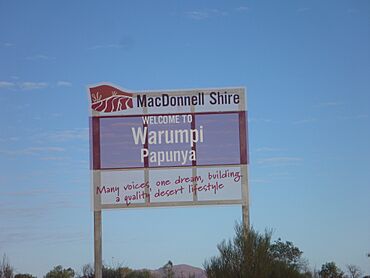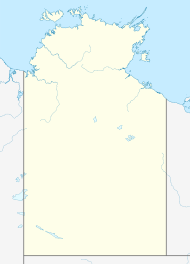Papunya facts for kids
Quick facts for kids PapunyaNorthern Territory |
|
|---|---|
 |
|
| Population | 404 (2016 census) |
| Location | 240 km (149 mi) NW of Alice Springs |
Papunya (also known as Warumpi in the Pintupi-Luritja language) is a small Indigenous Australian community. It's about 240 kilometers (150 miles) northwest of Alice Springs in Australia's Northern Territory. Papunya is famous for its important role in Contemporary Indigenous Australian art, especially the "dot painting" style started by the Papunya Tula artists in the 1970s. In 2016, about 404 people lived there.
Contents
A Brief History of Papunya
In the 1930s, Pintupi and Luritja people had to leave their traditional lands. They moved to places like Hermannsburg and Haasts Bluff. These areas had government food supplies. Life was often difficult for these people, who lived by hunter-gathering, as cattle farmers moved into their lands. The farmers used up the limited water, causing problems.
In the 1950s, the Australian Government built a water bore (a deep well) and some simple houses in Papunya. This was to make space for the growing number of people in existing Aboriginal communities. By the early 1970s, over a thousand people lived in Papunya. The community faced many challenges, including crowded living and disagreements between different language groups.
These problems led many people, especially the Pintupi, to move further west. They wanted to be closer to their traditional country. After living in several small settlements called outstations, the new community of Kintore was set up. Kintore is about 250 kilometers (155 miles) west of Papunya and was established in the early 1980s.
The "Finke River Mission" was originally the name for the mission at Hermannsburg. Later, this name also included settlements like Haasts Bluff, Areyonga, and Papunya. Today, it refers to all the Lutheran missionary work in Central Australia. This work began when the first mission was started at Hermannsburg in 1877.
Life and People in Papunya
Papunya is now home to many Aboriginal people, mainly from the Pintupi and Luritja groups. These are people who have moved from their original lands. At the 2016 Australian census, Papunya had a population of 404 people.
Most people in Papunya follow the Lutheran religion. The 2016 census showed that 310 residents, or 78.7% of the population, were Lutheran.
Papunya is the closest town to the Australian continental pole of inaccessibility. This is the point on the continent that is furthest from any coastline. Papunya is on special Aboriginal land, which means you need a permit to visit or travel through it.
The famous Australian country and Aboriginal rock band, Warumpi Band, was formed in Papunya.
The Art of Papunya
Papunya Tula Art Movement
Papunya Tula During the 1970s, a new and exciting art style began in Papunya. By the 1980s, this style became famous across Australia and then around the world. It is known as a major Indigenous art movement, often called "dot painting."
Important artists of this style belonged to the Papunya Tula art cooperative. This group was started in Papunya in 1972. Some of the leading artists included Clifford Possum Tjapaltjarri, Billy Stockman Tjapaltjarri, Kaapa Tjampitjinpa, Turkey Tolson Tjupurrula, and Pansy Napangardi. Today, the Papunya Tula company works from Alice Springs. It covers a huge area, reaching about 700 kilometers (435 miles) west into Western Australia.
Papunya Tjupi Arts Centre
Papunya Tjupi Arts is an art organization that started in 2007. It is owned 100% by Aboriginal people and is based in the community. As of March 2021, about 150 artists work there. Their artworks are shown in exhibitions and galleries all over the world. In 2009, Michael Nelson Tjakamarra became the main artist leader at the centre.
Many talented artists are part of Papunya Tjupi Arts. Some of them include Doris Bush Nungarrayi, Maureen Poulson, Charlotte Phillipus Napurrula, Tilau Nangala, Mona Nangala, Nellie Nangala, Carbiene McDonald Tjangala, Martha McDonald Napaltjarri, Candy Nelson Nakamarra, Dennis Nelson Tjakamarra, Narlie Nelson Nakamarra, Isobel Major Nampatjimpa, Isobel Gorey, Mary Roberts, Beyula Putungka Napanangka, and Watson Corby.
See also
 In Spanish: Papunya para niños
In Spanish: Papunya para niños


